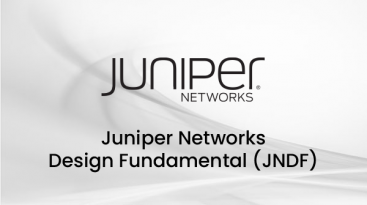Genel Bakış
This course is designed to cover introductory best practices, theory, and design principles for overall network design.
Eğitim Süresi 3 gündür.
Eğitim takvimi sayfamızda güncel eğitim tarihlerimizi bulabilirsiniz.
Eğitim Ön Koşulları
- Knowledge of routing and switching architectures and protocols.
- Knowledge of Juniper Networks products and solutions.
- Understanding of infrastructure security principles.
- Basic knowledge of hypervisors and load balancers.
Eğitim İçeriği
Course Introduction
Network Design Fundamentals
- A Need for Design
- Knowledge is King
- A Proposed Design Methodology
- A Reference Network
Understanding Customer Requirements
- RFP Requirements
- Scoping the Design Project
- Analyzing the Data
Organizing the Data
- Processing the Data and Requests
- Understanding Boundaries and Scope
- Design Proposal Considerations
Securing the Network
- Why Secure the Network?
- Security Design Considerations
Creating the Design—Campus
- The Campus Network: An Overview
- Best Practices and Considerations
- Architectural Design Options
Creating the Design—Wide Area Networks
- The WAN: An Overview
- Best Practices and Considerations
- WAN Design Examples
Creating the Design—Data Center
- The Data Center: An Overview
- Best Practices and Considerations
- Data Center Design Examples
Business Continuity and Network Enhancement
- Business Continuity Planning
- High Availability Design Considerations and Best Practices
- Offerings and Solutions
- CoS and Traffic Engineering Considerations
- Environmental Design
Network Management
- Designing for Network Management
Automation
- Designing for Network Automation
Putting Network Design into Practice
- Network Design Recap
- Responding to the RFP
- Final Lab Introduction
Eğitim Hedefleri
- Provide an overview of network design needs and common business requirements.
- Identify key product groups related to campus, WAN, data center, and security architectures.
- Describe and interpret common RFP requirements.
- Scope a network design by gathering data and working with key stakeholders.
- List ways of processing customer data and design requests.
- Identify boundaries and scope for the design proposal.
- List some considerations when creating a design proposal.
- Provide an overview of network security design principles and common vulnerabilities.
- List high-level design considerations and best practices for securing the network.
- List the components of the campus network design.
- State best practices and design considerations for the campus.
- Describe architectural design options for the campus.
- List the components of the WAN.
- Describe best practices and design considerations for the WAN.
- Describe design options for the WAN.
- List the components of the data center design.
- Describe best practices and design considerations for the data center.
- Describe architectural design options for the data center.
- Define business continuity and its importance in a network design.
- Describe high availability design considerations and best practices.
- Provide an overview of high availability offerings and solutions.
- Describe Class of Service design considerations.
- Provide an overview of environmental considerations in network design.
- List design considerations and best practices for managing the network.
- Provide an overview of Juniper Networks and third party options for network management.
- List design considerations and best practices for network automation.
- Provide an overview of automation tools.
- Explain the foundational topics that have been taught throughout the course.
- Create a network design proposal that satisfies customer requirements and business needs.
- Provide an overview of the steps involved in migrating a network.
- Describe best practices used in network migration.
- List the various campus network topographies.
- Describe sample design options for the campus.
Eğitime Kimler Katılmalı?
This course is targeted specifically those who have a solid understanding of operation and configuration and are looking to enhance their skill sets by learning introductory principles of network design.
- Genel Bakış
- Ön Koşullar
- İçerik
- Hedef
- Kimler Katılmalı?
Genel Bakış
This course is designed to cover introductory best practices, theory, and design principles for overall network design.
Eğitim Süresi 3 gündür.
Eğitim takvimi sayfamızda güncel eğitim tarihlerimizi bulabilirsiniz.
Eğitim Ön Koşulları
- Knowledge of routing and switching architectures and protocols.
- Knowledge of Juniper Networks products and solutions.
- Understanding of infrastructure security principles.
- Basic knowledge of hypervisors and load balancers.
Eğitim İçeriği
Course Introduction
Network Design Fundamentals
- A Need for Design
- Knowledge is King
- A Proposed Design Methodology
- A Reference Network
Understanding Customer Requirements
- RFP Requirements
- Scoping the Design Project
- Analyzing the Data
Organizing the Data
- Processing the Data and Requests
- Understanding Boundaries and Scope
- Design Proposal Considerations
Securing the Network
- Why Secure the Network?
- Security Design Considerations
Creating the Design—Campus
- The Campus Network: An Overview
- Best Practices and Considerations
- Architectural Design Options
Creating the Design—Wide Area Networks
- The WAN: An Overview
- Best Practices and Considerations
- WAN Design Examples
Creating the Design—Data Center
- The Data Center: An Overview
- Best Practices and Considerations
- Data Center Design Examples
Business Continuity and Network Enhancement
- Business Continuity Planning
- High Availability Design Considerations and Best Practices
- Offerings and Solutions
- CoS and Traffic Engineering Considerations
- Environmental Design
Network Management
- Designing for Network Management
Automation
- Designing for Network Automation
Putting Network Design into Practice
- Network Design Recap
- Responding to the RFP
- Final Lab Introduction
Eğitim Hedefleri
- Provide an overview of network design needs and common business requirements.
- Identify key product groups related to campus, WAN, data center, and security architectures.
- Describe and interpret common RFP requirements.
- Scope a network design by gathering data and working with key stakeholders.
- List ways of processing customer data and design requests.
- Identify boundaries and scope for the design proposal.
- List some considerations when creating a design proposal.
- Provide an overview of network security design principles and common vulnerabilities.
- List high-level design considerations and best practices for securing the network.
- List the components of the campus network design.
- State best practices and design considerations for the campus.
- Describe architectural design options for the campus.
- List the components of the WAN.
- Describe best practices and design considerations for the WAN.
- Describe design options for the WAN.
- List the components of the data center design.
- Describe best practices and design considerations for the data center.
- Describe architectural design options for the data center.
- Define business continuity and its importance in a network design.
- Describe high availability design considerations and best practices.
- Provide an overview of high availability offerings and solutions.
- Describe Class of Service design considerations.
- Provide an overview of environmental considerations in network design.
- List design considerations and best practices for managing the network.
- Provide an overview of Juniper Networks and third party options for network management.
- List design considerations and best practices for network automation.
- Provide an overview of automation tools.
- Explain the foundational topics that have been taught throughout the course.
- Create a network design proposal that satisfies customer requirements and business needs.
- Provide an overview of the steps involved in migrating a network.
- Describe best practices used in network migration.
- List the various campus network topographies.
- Describe sample design options for the campus.
Eğitime Kimler Katılmalı?
This course is targeted specifically those who have a solid understanding of operation and configuration and are looking to enhance their skill sets by learning introductory principles of network design.





